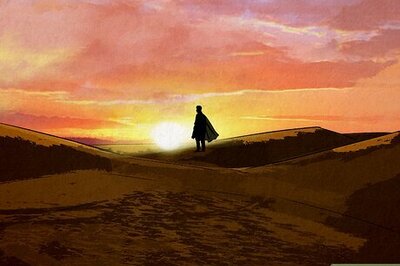
views
Blood Falls (Antarctica)
Taylor Glacier spews eerie gushes of red water into the frozen landscape. It earned the name “Blood Falls” due to the rusty, briny red-brown sea water that seems to spurt out of the glacier terminus like a wound. But why? Sediments trapped in super-salty water pockets under the glacier give the water its eerie color, but scientists are still trying to figure out just how the water travels from deep below to spill out into the sea. Google Earth coordinates: -77.7165° S, 162.2666° E
The Face in the Desert (Nevada, USA)
A creepy face appears to be etched into the ground in the Nevada desert. It’s not obvious from the ground, but air travelers and Google Earth explorers are in for a scary treat when traversing the southwestern desert. A human-like face appears to be carved into the ground—some speculate it’s the remnant of an ancient civilization, while others believe it’s a natural phenomenon (somehow). We may never know for sure! Google Earth coordinates: 37.401573° N, 116.867808° W
The Human Lips (Sudan)
A natural formation in the Sudan desert looks like a plump set of lips. From the air, a huge patch of sand about 1 kilometer (0.6 mi) long appears darker than the surrounding desert and oddly…lip-shaped. Lines of trees outline the top lip and Cupid’s bow, as well as the middle part between the “lips,” making this odd formation look eerily planned. No one is sure just how this unique formation in the desert came to be. Google Earth coordinates: 12° 22′ 13.32″ N, 23° 19′ 20.18″ E
The Badlands Guardian (Canada)
The profile of a humanoid face seems etched into the ground in Alberta. The face appears to be wearing what resembles a First Nations headdress while gazing off to one side. While the massive face seems almost manmade, it’s actually natural. Years and years of rainfall have eroded the clay-rich soil, eerily portraying the outlines of a larger-than-life figure to watch over the land. Google Earth coordinates: 50° 0′ 38.20″ N, 110° 06′ 48.32″ W
The Outback Triangle (Australia)
A lit-up triangle in the Outback may cause damage to aircraft computers. About a 3-hour drive from Perth, you’ll find a mysterious triangle of trees—whether it appeared naturally or was planted is anybody’s guess. At times, the corners of the triangle appear to light up, and rumors claim that airplane computers and navigation equipment go haywire when flying over it. What’s more, the triangle is almost exactly on the opposite side of the globe as the infamous Bermuda Triangle…could they be connected? Google Earth coordinates: 30.0305° S, 115.3565° E
The Broken Face (Antarctica)
A giant, cracked human face of stone emerges out of icy ground in Antarctica. The disturbing image is an object of speculation among Google Earth enthusiasts. Some claim it’s the door to an underground bunker, while others swear they’ve seen ice ships traversing the site. As it turns out, the face and ships are likely just rock and ice formations that look like recognizable shapes from certain angles…but who can travel to Antarctica to be 100% sure? Google Earth coordinates: 72° 00′ 36″ S, 168° 34′ 40″ E
Blood Lake (Iraq)
A horrifyingly red lake looks like a pool of blood in Iraq’s Sadr City district. Google Earth explorers discovered the eerie lake in 2007 and were shocked by how the crimson-red water stands out against the tan landscape. The cause? A combination of pollution and algae blooms. Nearby factories dump chemicals into the lake, while certain species of algae can cause red blooms in super salty water. However, the exact root of the water’s color is still up for debate. Google Earth coordinates: 33.3961° N, 44.4875° E Did you know? Iraq isn’t the only country with a “Blood Lake.” A similarly red body of water exists in Mongolia, and some locals believe it’s a portal to the underworld (however, scientists are pretty sure this one is caused by algae and other microorganisms).
The Ruins of Pripyat (Ukraine)
The town of Pripyat has sat abandoned ever since the Chernobyl disaster. In 1986, reactor 4 at the Chernobyl nuclear plant in then-Soviet Ukraine melted down and leeched devastating amounts of deadly radiation into the air. Pripyat, built in the 70s by the Soviets for Chernobyl workers, was hastily evacuated. Today, the ruins of the town feature broken windows, collapsed roofs, and trees growing through the pavement—an eerie memorial to the world’s worst nuclear accident. Google Earth coordinates: 51.4041° N, 30.0571° E
The Maree Man (Australia)
A massive geoglyph in the Outback desert resembles a giant human figure. The Maree Man was discovered in the late 90s and is about 4 kilometers (2.5 mi) long and 2.7 kilometers (1.7 mi) wide. Deep furrows dug into the ground around it make its origins and formation even more mysterious. Some even believe it’s evidence of alien life visiting Earth in the distant past—we may never be sure. Google Earth coordinates: 29.5324° S, 137.4694° E The Maree Man is a popular tourist attraction. Many visitors choose to fly over it so they can view it from the air.
The Nazca Lines (Peru)
Mysterious geoglyphs mar the landscape of Peru’s Nazca Desert. The series of massive glyphs depicts various animals, geometric patterns, and other shapes when viewed from the air, and scientists believe they were created by stripping away the top layer of iron-oxide pebbles to let the lighter-colored earth underneath show through. The purpose and origins of the Nazca Lines are unknown, with many attributing their creation to either extraterrestrials or a mysterious ancient people. Google Earth coordinates: 14.7390° S, 75.1300° W
The Gates of Hell (Turkmenistan)
A flaming crater in the Karakum Desert looks like a portal to Hell itself. The massive gas crater in Turkmenistan is the result of an old Soviet drilling accident. An exploratory drill team looking for natural gas caused the entire site to collapse (the exact cause is a mystery due to missing Soviet records). A series of natural gas fires have been burning in the hole ever since the incident in the early 1970s (the exact date is also unknown). Google Earth coordinates: 40.2525° N, 58.4395° E Government efforts by Turkmenistan to put out the fire failed, and the crater continues to burn today. However, it appears that the flames are very gradually starting to subside.
The Pentagram (Kazakhstan)
A 5-point star is carved into the ground in a remote area of Kazakhstan. Measuring about 1,200 feet (366 meters) in diameter, the giant upside-down star resembles a magical pentagram, leading many to believe that the symbol has occult origins. However, it’s more likely that the lines of the star are worn-out walking trails within the outline of an old park (but who’s to say the park isn’t an occult one?). Google Earth coordinates: 52°28’48.4″N 62°11’09.6″E
The Scarecrow Village of Nagoro (Japan)
The residents of this small Japanese village are not quite what they seem. If you peruse the streets of Nagoro on Google Earth, you’ll notice that all the residents in the photos are not living humans, but actually life-sized scarecrows that are posed around town doing everyday business. The scarecrows represent real former residents of the town, which has been shrinking as the population ages or moves elsewhere. The scarecrows currently outnumber the remaining residents by 10 to 1. Google Earth coordinates: 33.8444° N, 134.1559° E The scarecrows were the idea of craft hobbyist Tsukimi Ayano, who made the first scarecrow in honor of her father in 2002.
SS Ayrfield Shipwreck (Australia)
A broken-down shipwreck haunts Homebush Bay in the suburbs of Sydney. Called the “Floating Forest,” this eerie wreck is overrun by trees and plant growth, appearing as a rusty island in the river. Built in 1911, the SS Ayrfield hauled cargo along Australia’s coasts before being retired and sent to a scrapyard in the 70s. However, the job was never finished, and the mangrove-covered wreck remains a hauntingly beautiful symbol of the relationship between nature and civilization. Google Earth coordinates: 33°50'11.0"S 151°04'49.8"E
Trementina Base (New Mexico, USA)
A top-secret base lies beneath the desert near Mesa Huerfanita. This isolated spot was built by the Scientologists to permanently house the religion’s founder L. Ron Hubbard’s writings and recordings. The base is tightly guarded, so no one is sure what’s inside—rumors say it’s a maze of subterranean tunnels immune to nuclear bombs. The strange circular carvings on the ground above the base are said to guide Scientologists to the site from space. Google Earth coordinates: 35°31'28.56"N, 104°34'20.20"W The area near Trementina Base is filled with other creepy lore, including UFO sightings and evil spirits trapped in caves.
The Ancient Wheels of Jordan (Jordan)
Over 1,000 wheel-shaped structures dot the landscape of the Azraq Oasis. Also called “the works of the old men,” these creepy structures are about 2,000 years old and some of them are as wide as 70 meters (76.5 yards). First spotted by pilots in the 1920s, no one is sure why these wheels were built. They appear to align with the winter solstice and other astrological events, hinting that they may have had an ancient ceremonial or timekeeping purpose. Google Earth coordinates: 31.029° N, 37.641° E
The Boneyard (Arizona, USA)
The world’s largest junkyard for airplanes lies deep in the Arizona desert. Officially called the 309th Aerospace Maintenance and Regeneration Group (AMARG), the site houses over 4,000 retired military aircraft and missiles, all parked in creepy rows under the hot desert sun. Originally founded to hold leftover planes after WWII, the dry air and hard ground help preserve these planes—and rumor has it the ghost of a pilot haunts the site. Is unfortunately not open to the public, although occasional tours and events are held there. Google Earth coordinates: 32° 10′ 15.20″ N, 110° 51′ 18.66″ W Fun fact: The Boneyard was used as a filming location for Transformers: Revenge of the Fallen (2009).
The Sunken City of Baia (Italy)
This once-luxurious Roman resort town is now a creepy underwater city. Hot springs, stunning views, and a fast-paced social scene once made this ancient city a favorite getaway for wealthy elites and even Roman emperors. However, volcanic activity caused the ground beneath Baia to slowly sink into the Mediterranean, transforming the site into an eerie, watery park. What’s more, Baia was originally said to sit atop an entrance to the underworld from Greek mythology—who knows what divers might discover there next? Google Earth coordinates: 40.8184°N, 14.0769°E
Underwater Plane Wrecks (The Bahamas)
Infamous plane wreckage dots the warm blue waters of the Bahamas. Cartel leader Pablo Escobar’s drug plane crashed into shallow water in the 80s, leaving behind a twisted metal frame that’s now a hauntingly beautiful haven for many fish species. That’s hardly the only creepy site in the area, though. Wrecks near Staniel Cay and Bimini Island reveal more crashed drug planes, and even the fatal 2001 flight that killed the singer Aaliyah. Google Earth coordinates: 24° 35' 40.3368" N, -76° 48' 36.4098" W
The Ghost Town of Rhyolite (Nevada, USA)
The ruins of this goldrush hot spot litter the desert near Death Valley. Located outside of Las Vegas, Rhyolite was a bustling prospector town in the early 1900s. It sprang up nearly overnight in 1905, but by 1910—when the goldrush fervor in the area had died—the town was abandoned as fast as it was built. The ruins of buildings stand alongside eerie sculptors made by international artists, turning the historical site into a creepy outdoor museum. Google Earth coordinates: 36.9005° N, 116.8273° W
The Pigeon People (Japan)
People in realistic pigeon masks haunt Google Earth images of Tokyo. Students in the Tamagawa-josei neighborhood of West Tokyo dressed themselves in pigeon masks and stood in creepy lines for Google Maps photographers as a prank. Today, if you scan the city in Street View, you’ll get to experience a real jumpscare when you come across these scary (but kind of hilarious) pranksters. Google Earth coordinates: 35.7040744° N, 139.5577317° E
Hidden Flying Saucer (Antarctica)
A mysterious spacecraft-looking object sits atop a frozen glacier. Satellite images seem to show a distinct, flying saucer shape jutting out from under a massive rock and sitting partially on top of an ice sheet. Many speculators were quick to point out it looks like a buried (or crashed) alien spacecraft, slowly being revealed by melting ice. What’s more likely, though, is that the saucer is actually just a meltwater pond—there are several others nearby with similarly round shapes. Google Earth coordinates: 80°34'08.4"S, 30°05'19.3"W
The Shadow People (Antarctica)
Mysterious silhouettes of human faces seem to lie on the ice in Antarctica. Dark rock formations and landforms stand out easily against the white snow and ice of the southernmost continent. One of these formations forms the silhouette of two massive faces gazing out across the barren, frozen landscape to the left. Although it’s formed by nature, these “shadow people” are a creepy reminder of the wild, unexplored, and mysterious inner regions of Antarctica. Google Earth coordinates: -72° 1' 22.8174" S, 2° 49' 18.177" E
The Coast-Horned Lizard (North America)
These lizards shoot blood from their eyes to defend themselves. These unique lizards, from the genus Phrynosoma, have developed a defense mechanism that’s straight out of a horror movie. When threatened from the front, these lizards (who prefer to camouflage themselves in the sand instead of running for cover) will shoot blood from tiny slits beneath their eyes to scare off predators. The act is rarely observed by humans—it seems the lizards save this for predators native to their natural habitat, like foxes or coyotes. Found in: Western and central North America
Flying Snakes (South Asia)
There are 5 snakes species that can attack you from the ground and the air. No, these snakes aren’t on a plane—they live in tropical habitats from Indonesia to India and can glide up to 2 dozen meters (79 feet) between trees. After leaping, they wiggle their aerodynamic bodies like horrific sea serpents, never having to touch the ground. If this sounds like a nightmare, don’t fret too much—their venom is weak, and they have tiny fangs set in the back of their mouth, making them harmless to humans (physically, at least…you may need some emotional support if one lands on you!). Found in: South Asia and the Indonesian archipelago
The Stargazer Fish (Atlantic & Pacific Oceans)
This horrifying fish waits just beneath the sand to pounce on its prey. “Stargazer” sounds like a pretty name, but this beast is hideous—it buries itself in the sand with only its razor-sharp teeth and creepy, bulging eyes showing, gazing up toward the surface. Venomous spines and the ability to electrically shock its prey complement this fish’s creepy looks, making it one of the scariest monsters in the sea. Found in: Warm, shallow waters along the coasts of the Atlantic and Pacific oceans
Zombie Fungus (Tropical environments)
This fungus takes over the bodies and minds of ants to reproduce. Known scientifically as Ophiocordyceps unilateralis, the zombie fungus sounds like something straight out of a sci-fi movie. As ants pick up fungal spores from the ground on accident, this parasitic fungus drills inside their bodies and begins to spread. Once it reaches a certain point, the ant’s behavior changes—instead of following the pheromone trails of other ants in the colony, the fungus directs it to attach itself to a leaf with its jaws. The fungus then kills the ant and sprouts a stalk from its head several days later, creating more spores to find unsuspecting carpenter ants. Found in: Tropical and temperate forests worldwide PS—humans can’t be infected by the zombie fungus. In fact, out of the millions of species of fungus, there are only a few hundred that infect humans (and they mostly lead to athlete’s foot or yeast infections).
The Wow! Signal (Big Ear radio telescope, Ohio, USA)
A 72-second radio wave blast detected in 1977 is still a mystery. The mysterious and intense signal from outer space was detected at the Big Ear radio observatory at Ohio State University. It was unlike anything astronomers had detected before and didn’t seem to be caused by any known natural phenomena—in fact, it seemed eerily artificial. A researcher printed out the data, circled the signal, and wrote “Wow!” next to it, giving this signal its name. No one knows what caused it or where it came from to this day. Location in space: The signal came from the direction of the constellation Sagittarius. Many believe the signal was created by intelligent life (whether on purpose or on accident, we may never know. Other explanations for the signal include radiation from a comet, human-made radio interference, or, most recently, the collision of a magnetar (a hyper-dense star with an insanely strong magnetic field) and a cold interstellar cloud of hydrogen gas.
The Voyager Probes (Interstellar space)
Voyager 1 and 2 are wandering space with golden records of human voices. Both launched in 1977, the Voyager probes were outfitted with gold-plated copper discs with playing instructions and information on how to locate the Earth etched onto them. The records contain the sounds of Earth, like thunder, birds, and music of multiple genres, as well as greetings recorded in 55 human languages. The probes left the solar system in the 2010s—the first human-made spacecraft to do so—and will wander the cosmos forever until they’re found by distant spacefarers. Location in space: Voyager 1 crossed the heliopause (the outer boundary of the sun’s solar wind) and entered interstellar space in 2012. Voyager 2 followed in 2018.
Sagittarius A* (Milky Way galaxy)
This supermassive black hole devours stars at the heart of our galaxy. Only 26,000 lightyears from Earth, a black hole that’s over 4 million times the mass of the sun is gobbling up hot gas and star remnants that are drawn into the center of the galaxy by gravity. Like all black holes, nothing can escape Sagittarius A* if it gets too close—not even light (and especially not any spacecraft that attempt to visit the black hole up close, so don’t get any bright ideas). We can rest easy that Earth is outside the grip of this cosmic behemoth…for now. Location in space: The center of the Milky Way galaxy Did you know? Astronomers and physicists believe that nearly all galaxies have a supermassive black hole at their centers. Some theories suggest these gravitational monsters help galaxies form and grow.
The Great Attractor (Deep space)
This mysterious cosmic force is rapidly pulling the Milky Way toward itself. There is a mysterious region of space about 150-250 million lightyears from Earth that’s dragging the Milky Way—and thousands of other galaxies around us—toward it at a breakneck speed of 600 kilometers (373 miles) per second. Although this area is within the observable universe, we’re unable to see it because of the light interference from our own galaxy—talk about a creepy journey for the entire planet! Location in space: The gravitational center of the Laniakea galactic supercluster Fun fact: The Great Attractor sounds like it could be the end of the galaxy, but we’ll never actually reach it. Because of the expansion of the universe, the Great Attractor is actually moving away from us faster than it can pull us in.

















Comments
0 comment